Thursday, July 3, 2025. Annette’s Roundup for Democracy.
Trump is always greedy. Trump always lies.
The New York Times decided to become brave and expose Trump’s lies.
This 👇 was yesterday’s headline in the digital Times.
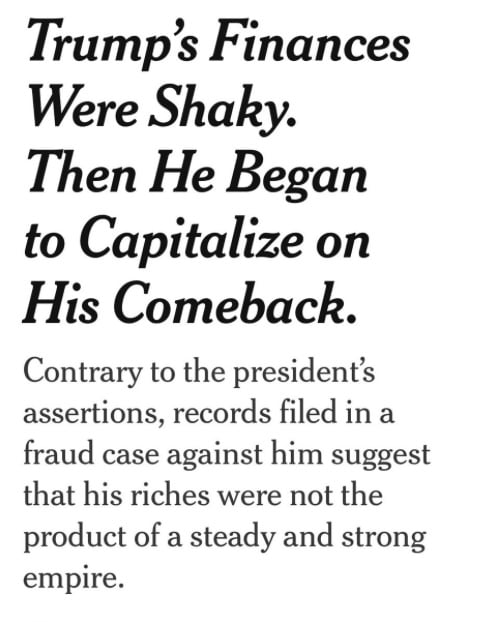
Trump’s Finances Were Shaky. Then He Began to Capitalize on His Comeback.
Contrary to the president’s assertions, records filed in a fraud case against him suggest that his riches were not the product of a steady and strong empire.

An attendee posed with a cutout of President Trump at a Bitcoin conference in Las Vegas at the end of May.Credit...Gabriela Bhaskar/The New York Times.
Last spring, even as Donald J. Trump’s march back toward the White House dominated public attention, his finances, largely out of view, faced serious threats.
His office building in Lower Manhattan generated too little cash to cover its mortgage, with the balance coming due. Many of his golf courses regularly lacked enough players to cover costs. The flow of millions of dollars a year from his stint as a television celebrity had mostly dried up.
And a sudden wave of legal judgments threatened to devour all his cash.
Then, with his clinching of the Republican nomination, everything began to change.
In the following months, Mr. Trump, along with his two eldest sons, Eric and Donald Jr., refocused the family business, forming a series of partnerships, especially in cryptocurrency, with investors who were willing to bank on his victory.
Once Mr. Trump won the presidency in November, that approach kicked into overdrive.
His family business announced numerous new deals that would financially benefit Mr. Trump directly, even as he made policy decisions that affected those industries or that involved countries in which the United States had political interests. Most glaringly, Mr. Trump is now both a partner in several crypto ventures and, as president, crypto’s chief policy regulator, and he has signaled that he wants his administration to have a hands-off approach to digital currencies.
Today, those moves are seen by Mr. Trump’s detractors as a money grab of historic proportions. But an analysis by The New York Times of thousands of pages of internal Trump Organization documents filed in one of the legal actions against him suggests a more urgent motivation for Mr. Trump’s behavior: a need, rather than simply a desire, for easy money to keep his empire intact.
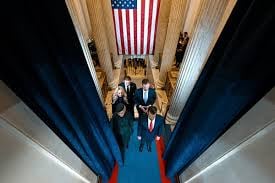
Donald Trump Jr., front right, and Eric Trump, behind him, have shifted the focus of the family business from real estate development to deals that monetize the family name and now, intentionally or not, the office of the presidency..credit. Pool photo by Kenny Holston.
In late 2023, Mr. Trump boasted of having between $300 million and $400 million in cash when he testified as part of that legal action, a lawsuit brought by the New York attorney general that accused the Trumps of defrauding their lenders. His cash stockpile, Mr. Trump said, showed “how good a company I built,” and, he added in earlier testimony, “especially for a developer.”
Contrary to those assertions, records filed in the fraud case suggest that Mr. Trump’s cash was not the product of a steady and strong empire. His balance had fluctuated wildly, hitting a low of $52 million in 2018, a small figure for the size of his operation. The subsequent increase came largely from the sale of properties and a payout of more than $150 million from a passive investment.
Moreover, the version of Mr. Trump’s business that he projects — a real estate development company that executes large, complex tasks — hasn’t existed for a nearly a decade, since the Trumps’ last two major construction projects failed to make money.
Instead, Mr. Trump’s wealth is now built on monetizing the family name in new ways and, intentionally or not, the office of the presidency. It is an enterprise in pursuit of multimillion-dollar checks — from actual real estate developers, from cryptocurrency and social media enterprises run by others. It is also a business that hawks Trump-branded trinkets like watches and gold-toned mobile phones to the president’s passionate supporters.
Many of the deals open multiple channels for anyone to funnel cash to a sitting president, often in ways that are untraceable under current disclosure requirements. And because some of what is being sold is use of the president’s name, there are no clear metrics to gauge whether he has received market rate, a premium because of his office or, in effect, a hopeful bribe.
The White House press secretary, Karoline Leavitt, has said that Mr. Trump abides by all conflict-of-interest laws and acts with only the interests of the American public in mind.
In response to questions from The Times, Eric Trump, who runs his father’s businesses, issued a written statement saying the company is stronger than ever and largely debt free thanks to “the most iconic” properties and “cryptocurrency ventures on Earth.”
“I have never been more proud of our company,” the statement said. “Our portfolio is operating flawlessly, and 2025 will mark the strongest year in the remarkable history of the Trump Organization.”
Perfectly assessing Mr. Trump’s privately held businesses at any point in time is nearly impossible. But within months of his testimony in the New York civil fraud trial, all of his cash and liquid investments looked to be at risk.
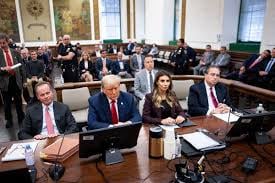
President Trump in the courtroom during proceedings for his civil fraud trial in 2023 in Manhattan.Credit...Doug Mills/The New York Times
His businesses had often required cash infusions before a judge in the trial entered a judgment against the Trumps of $355 million. Mr. Trump faced a second judgment of $88.3 million in the sexual abuse and defamation lawsuits brought by writer E. Jean Carroll.
Mr. Trump has not yet had to pay the judgments, which now total more than $600 million with interest. But he did have to put up cash totaling $175 million in the fraud case, and cash and bonds totaling $97 million in Ms. Carroll’s cases, to pursue appeals.
He also faced a potential hit of $100 million from a longstanding tax audit, though it now appears unlikely that his political appointees at the Internal Revenue Service would sign off on such an assessment — another benefit of having returned to the Oval Office.
To be sure, Mr. Trump was not facing a calamity. He could have sold more properties, at the expense of his family’s future wealth, to cover any shortfall.
The Trumps found a different path.
“His approach to almost everything at this point now seems to be that he’s going to get away with whatever he can get away with, and sort of dare people to try to find legal or political ways to stop him,” said Noah Bookbinder, president of the watchdog group Citizens for Responsibility and Ethics in Washington, a liberal-leaning nonprofit group.
Escalator to Nowhere

Ropes blocking off a pair of escalators in Trump Tower last month. The stores on the top retail floors have departed over the years. Credit...Ahmed Gaber for The New York Times
When Mr. Trump completed construction on Trump Tower four decades ago, its five-floor atrium was filled with luxury retailers from around the globe — Asprey of London, Buccellati, Cartier — creating a destination for high-end shoppers and tourists alike.
Those spaces, and the office rentals above, provided Mr. Trump with one of his most reliable sources of profits for decades, a 2020 analysis of his tax returns by The Times found.
The famed shimmering escalators leading up to the top retail floors are now roped off, the stores there having departed over the years. Two smaller spaces on the ground floor and below offer Trump-branded merchandise, like license-plate frames and sweatshirts.
The atrium’s signature design feature — a multistory marble water wall — has been turned off and covered by a large U.S. flag. Only one major retailer remains: Gucci, in the one space with visibility from the sidewalk.

On the ground floor of Trump Tower, a worker staffed a shop selling Trump-branded memorabilia.Credit...Ahmed Gaber for The New York Times.
At 40 Wall Street, Mr. Trump’s office tower in Lower Manhattan, 25 percent of the building has been vacant since last year. In March, Fitch Ratings reported that, after covering basic expenses, the building generated $2 million per year less than Mr. Trump needed for his mortgage payments, and in a few years he will face a multimillion-dollar jump in the rent he pays for the ground under the building.
Vacancies have also haunted Mr. Trump’s most recent large-scale construction site, a 92-story tower in Chicago. With most of the apartments and hotel rooms sold off years ago, Mr. Trump’s ownership stake is comprised mostly of some 70,000 square feet of retail space that he had hoped would produce millions of dollars a year in rental income. Designed below street level with little visibility to passers-by, those floors remain empty 16 years after the building was finished.
Things did not go measurably better with Mr. Trumps’ redevelopment of the Old Post Office in Washington, which opened as a hotel in 2016. He never recorded a profitable year there — despite its becoming a destination for acolytes of Mr. Trump during his first administration.
He sold his interests in 2022 to a private equity firm for $375 million, a price that elicited excitement from the Trumps. “To say the result is a financial success would be an understatement,” Eric Trump wrote in an email to company employees.
But company documents filed in the fraud case show that the sale did not cover Mr. Trump’s costs on the project.
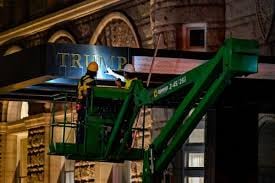
Construction workers removing branding from what was the Trump International Hotel in 2022, when it was sold to a private equity firm.Credit...Kenny Holston for The New York Times
The hotel’s buyer could not cover closing costs and borrowed $28 million from the Trumps before defaulting on the loan. Without that repayment, Mr. Trump was going to be left with $79 million from the sale after paying taxes, according to a spreadsheet created by his accountant and filed in the fraud lawsuit. Another company record filed in the case shows that he had invested about $100 million in the project.
It has now been nearly a decade since the Trumps completed the hotel. The years since have been marked by contraction.
In addition to the Washington hotel, in recent years Mr. Trump has sold control of a golf course in the Bronx, a mansion in Los Angeles, land on a Caribbean island, numerous luxury condominiums that he had held as rentals in buildings he constructed and the developable land around his golf course near Los Angeles.
Each sale brought a wave of cash, but also a diminished opportunity for future earnings.
Not Looking to Build

Golf club covers with the likeness of Mr. Trump for sale at the pro shop at Trump National Doral, a golf resort near Miami. Mr. Trump has spent hundreds of millions of dollars remaking golf courses to his tastes.Credit...Scott McIntyre for The New York Times.
Mr. Trump rarely escapes to anywhere on weekends and vacations other than his own golf courses, where he goes to exercise, relax and be seen.
He has said that those 14 courses do not represent a “major business” for him, rather investments that reflect his love of the game. He spent hundreds of millions of dollars remaking them to his tastes, often with ornate clubhouses and elaborate artificial waterfalls.
Those investments have not always paid off.
A golf course appraisal expert for the New York attorney general’s office examined the financial records of all but one of Mr. Trump’s golf courses for 2011 through 2021 and found that at least half of them reported negative cash flow for multiple years.
One email showed Allen Weisselberg, the company’s longtime head of finance, notifying Mr. Trump’s two elder sons that the Trump Organization produced only $2.2 million in 2017, before taxes or disbursements to the family. A primary culprit was the golf courses, where the Trumps had spent almost $13 million more than planned on maintenance and improvements, while the courses brought in $15 million less in operating profits than expected.
Mr. Trump has also described his courses as real estate development projects in waiting. But the Trumps have not created a record of success toward that goal. Their efforts to add homes to his two courses in Scotland, for example, stalled.
The Trumps did win approval in January for a major development in the parking lot at Trump National Doral, a golf resort near Miami. The project would include nearly 1,500 condominium apartments and more than 140,000 square feet of commercial space.
But that plan does not appear to be the one that will restart the Trumps’ real estate development business anytime soon.

An appraisal of Trump National Doral, Mr. Trump’s highest-revenue resort, concluded that since Mr. Trump entered politics, his divisive comments had hurt the business.Credit...Scott McIntyre for The New York Times
During his deposition in the fraud case, Mr. Trump said that he might build there in a decade, leave it for his children to develop or “sell it to another developer for a lot of money and let them do it.” He said he often sought zoning approval to develop, just in case.
Regardless, Mr. Trump added, “we’re not actively looking to build.”
In 2021, Deutsche Bank, which held Mr. Trump’s mortgage, hired the firm Newmark to appraise Doral, Mr. Trump’s highest-revenue resort, with four courses and 643 hotel rooms. The resulting analysis concluded that Mr. Trump had spent $379 million buying and renovating the resort, and that it was worth only $297 million.
The appraisal included an even more jarring finding. While Doral, like several of Mr. Trump’s properties, was known to benefit from people looking to buy proximity to a president during Mr. Trump’s first term, his managers believed even more potential customers stayed away because of him.
Mr. Trump’s divisive public comments over time had pushed down bookings and room rates for six years running, his managers told the appraisers. The managers believed that “the Trump brand has negatively impacted” revenues at Doral.
Newmark’s experts agreed, writing that “we believe that with a different brand, the subject might perform better.”
Spigot Turned Back On

A golf resort in Qatar is one of nine foreign branding deals the Trumps have made since last July — in countries with fast-growing luxury real estate sectors.Credit...Karim Jaafar/Agence France-Presse — Getty Images.
The Doral appraisal highlights perhaps the starkest turn in the Trump family’s finances.
The value of the Trump name as a brand on real estate projects and mass-market consumer goods made by others, both here and abroad, was central to sustaining his businesses during his peak years on “The Apprentice.”
The annual reports that the Trumps sent to their lenders showed television and licensing profits totaled $259 million from 2011 to 2017. But even with that deluge of cash, Mr. Trump still reported an overall negative cash flow of $46.8 million from his empire.
Donald Trump Jr. testified glowingly during the fraud trial about those licensing deals. Compared with real estate development, they required no investment and little labor.
“I don’t want to say it was free revenue,” he said, but “it was a pretty spectacular system that we were able to create.”
But the cash gusher from entertainment had slowed to a trickle by the time Mr. Trump entered politics, and after he entered the White House in 2017, the company fell into a dry spell for new licensing deals. Some of that was because the Trump Organization pledged not to sign new foreign deals in an attempt to avoid conflicts of interest.
After Mr. Trump left office in January 2021, the Trump Organization did not announce a major new branding agreement until late 2022 — for a golf resort in Oman.
The spigot of foreign branding deals did not fully turn back on until after Mr. Trump clinched the Republican nomination and a second term seemed within reach.
After that, nine deals were announced in rapid succession: one each for developments in Vietnam and Serbia, two in India and five on the Arabian Peninsula, including a golf resort in Qatar, a residential tower in Jeddah, another tower in Dubai and two more in Riyadh.
All but one of the new licensing contracts came from relationships that predated Mr. Trump’s first presidency. And some of those paying for the Trump name have made clear that his official stature was part of the attraction.
Kalpesh Mehta, a real estate developer in India, signed his first licensing deal with the Trumps 12 years ago. Mr. Mehta has said that he met Donald Trump Jr. while they were both studying at the Wharton School of the University of Pennsylvania. Donald Trump Jr. has joked that they are “like an old married couple.”
During inaugural events in January of this year, Mr. Mehta met with Eric Trump at Mar-a-Lago and the president-elect at the Trump golf course in Virginia. Weeks later, the Trumps and Mr. Mehta signed a new licensing deal for a commercial office tower in Pune, India. They announced yet another deal — their sixth — in April.
Mr. Mehta did not respond to requests for comment but has said that Trump-branded properties draw heightened interest in India.
Mr. Trump’s deals on the Arabian Peninsula all share a connection to one man: Ziad El Chaar, a Lebanese-born construction executive who first brought Mr. Trump into a branding agreement in 2013, for a golf course in Dubai, through a construction company based there called DAMAC.
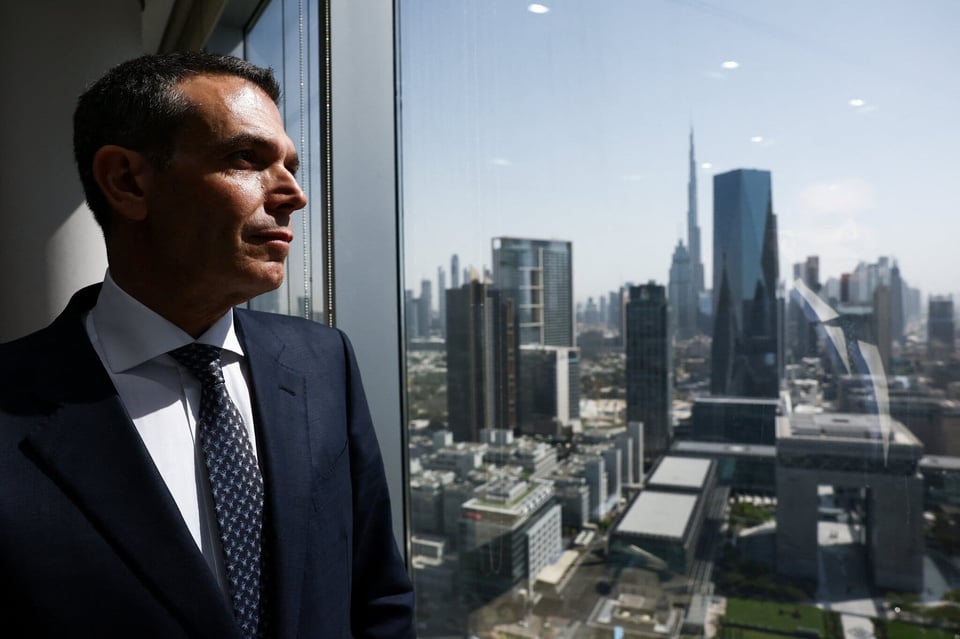
Ziad El Chaar, chief executive of DarGlobal, a Saudi Arabian company that has signed multiple deals with the Trumps, including five since last summer.Credit...Amr Alfiky/Reuters
Mr. El Chaar has since become chief executive of DarGlobal, a subsidiary of Dar Al Arkan Real Estate, a large Saudi Arabia-based construction company with ties to the Saudi government. He has signed five more deals with the Trumps since last summer.
During a DarGlobal event introducing the Oman project, Mr. El Chaar said the Trump name “immediately put the project on the global map.”
Through a spokesperson, Mr. El Chaar declined to discuss DarGlobal’s contracts with the Trumps.

A billboard promoting a partnership between DarGlobal and the Trumps to develop a golf club in Oman.Credit...Andrea DiCenzo for The New York Times.
Financial support from Saudi Arabia has also helped Mr. Trump’s golf courses.
Since 2022, the Saudi-backed LIV Golf league has paid him to host annual tournaments at his resorts in Doral, Fla., and Bedminster, N.J. Neither the league nor Mr. Trump has revealed the amount of money involved. Mr. Trump has used his presidential bully pulpit to advocate for a merger between the U.S.-based PGA Tour and LIV Golf, which could reunite the world’s top golfers on courses Mr. Trump owns.
On his federal financial disclosure forms, Mr. Trump has not been required to divulge the full amount promised to him in any of his licensing deals, only what he receives during a given year, which sometimes includes a management fee.
What information he has released suggests that the Trumps have raised the price for use of their name.
Mr. Trump’s tax returns during his television celebrity years showed payments in round numbers when he signed a licensing contract, typically $750,000 or $1 million. Financial disclosure forms he recently filed showed payments of exactly $5 million each for the deal in Vietnam and one with Mr. El Chaar’s company.
But in terms of the potential for anyone, from anywhere, to transmit hundreds of millions of dollars to a U.S. president, the recent wave of licensing agreements was only a warm-up.
A Massive Stockpile

At a Bitcoin conference in Abu Dhabi last December, Eric Trump was invited to appear as the keynote speaker.Credit...Tamir Kalifa for The New York Times.
Last December, just months after Mr. Trump and his two eldest sons made their first public comments in support of digital currencies, Eric Trump was invited to appear as the keynote speaker at a Bitcoin conference in Abu Dhabi.
He addressed the question he presumed to be on everyone’s mind: Why are you here?
“I know all of you are thinking: ‘Eric, you’re from real estate family. You’ve spent your entire life in real estate, concrete, drywall,’” he said. “I built Trump Chicago,” he added twice, referring to a four-year project completed when he was 24.
Sixteen years after completion of the Chicago tower, the Trumps still invoke its memory to establish business gravitas and their chosen identity as real estate developers.
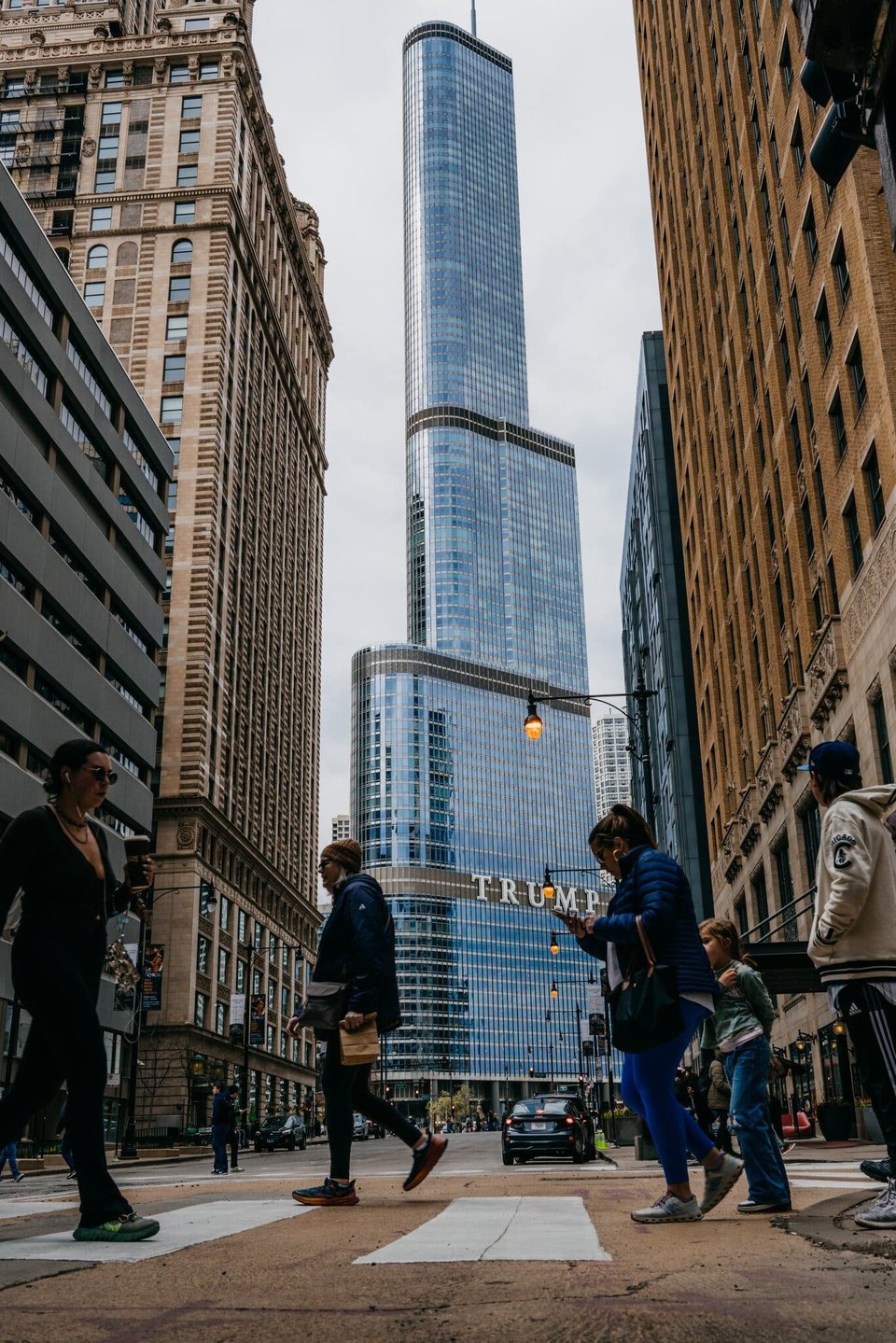
Members of the Trump family still cite their Chicago tower 16 years after its completion in order to establish business gravitas and their chosen identity as real estate developers.Credit...Jamie Kelter Davis for The New York Times.
But their recent moves into crypto and other enterprises bear more in common with Mr. Trump’s licensing deals: little or no investment, risk or operational responsibility. Mr. Trump, and to a lesser extent his sons, generally serve as a means to draw attention and convert the president’s political supporters into investors and paying customers.
Mr. Trump has invested nothing in Trump Media, the parent company of the social media site Truth Social, and has no official duties. But he received more than half of the company’s stock, a stake that has fallen in value but is still worth $2 billion.
In crypto, the Trumps have entered into a series of partnerships. Their partners were the ones who have invested most or all of the capital, or raised money through token sales, and run the businesses. The crypto coins issued to the Trump family through its first foray into the sector, World Liberty Financial, have recently been worth at least $236 million.
The Trumps’ sale of memecoins, otherwise worthless collectible digital trinkets, has been particularly lucrative. The fees collected by Mr. Trump and his associates on those sales have so far totaled $320 million, according to Chainalysis, a crypto analytics firm. The memecoins have proved to be a multimillion-dollar leap from the Trump-branded Bibles, guitars and watches that the Trumps sold during last year’s campaign.
The long-term viability of the new businesses remains unclear, as does the liquidity of some of Mr. Trump’s holdings in them. He cannot yet sell most of his crypto coins. And he would most likely crush Trump Media if he unloaded his stock, even as the company continues to lose money and struggles to produce $1 million per quarter in revenue, roughly the average of a single McDonald’s restaurant.
But the new cash has already helped solve old problems.
Last month, the Trumps paid off the $115 million mortgage coming due on 40 Wall Street. Analysts had said that the building’s low rental income would make banks squeamish about refinancing.
Going forward, the new enterprises represent a massive stockpile with the potential to cover legal judgments, mortgage payments and holes in balance sheets for years to come.
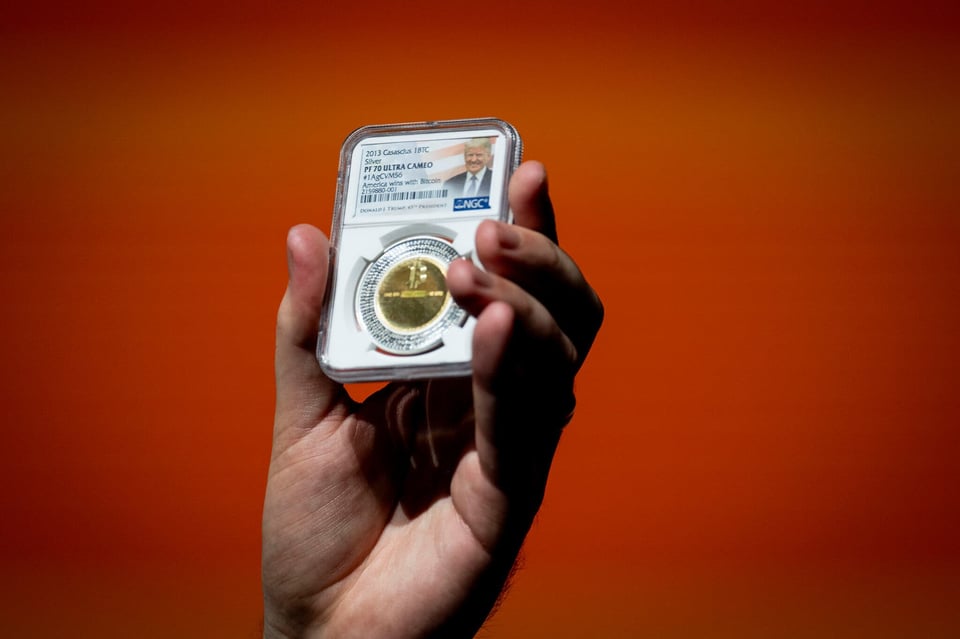
An attendee at a Bitcoin conference in Nashville last July held up a Bitcoin token bearing Mr. Trump’s likeness.Credit...Doug Mills/The New York Times.
Is there no limited to Trump’s cruelty?
REPUBLICAN DONORS CASH IN ON ‘ALLIGATOR ALCATRAZ’ IMMIGRANT CAMP
Trump and DeSantis donors reportedly helped build out the new immigrant detention camp in “Alligator Alley.”
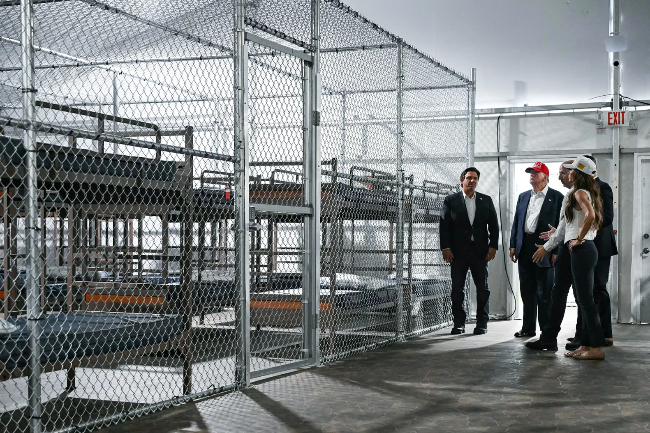
Florida Gov. Ron DeSantis, Trump, and Homeland Security Secretary Kristi Noem tour "Alligator Alcatraz" on July 1, 2025.
President Donald Trump traveled to Florida on Tuesday to tour what Republicans have dubbed “Alligator Alcatraz,” a 5,000-bed immigration detention center built in a remote, hot, and disgustingly humid corner of the Everglades. The facility — a collection of plastic tents outfitted with bunk beds in literal cages — was built almost overnight on top of an abandoned airstrip in an area known as Alligator Alley.
Republicans have emphasized the amount of deadly wildlife surrounding the camp and the danger alligators and pythons might pose to any detained migrants who may attempt to escape. The state GOP is even selling disturbing, swamp-themed merchandise touting the project, and Trump on Tuesday said, “I guess that’s the concept,” to a question about whether undocumented immigrants will be eaten by alligators if they try to escape.
But so far, little has been said about how exactly the facility came to be.
As it turns out, two contractors who worked to quickly build out Alligator Alcatraz, which Florida Gov. Ron DeSantis (R) has called a “one-stop shop” for detention, adjudication, and deportation of migrants, have been significant donors to DeSantis and Trump.
Trump and DeSantis, who were bitter rivals in the 2024 Republican presidential primary, toured Alligator Alcatraz together on Tuesday alongside Kristi Noem, who leads Trump’s Department of Homeland Security (DHS). “Ron worked beautifully with Kristi and all of the people at Homeland Security and got it done in how many days, Ron?” Trump marveled.
Earlier Tuesday, Bloomberg News identified several contractors working on Alligator Alcatraz — a group of disaster relief firms selected by Florida’s Division of Emergency Management, which is part of DeSantis’ administration.
Among the contractors is CDR Companies, which Bloomberg reported “will run medical services and did some site preparation.” CDR’s president Carlos Duart and businesses affiliated with his firm have made significant donations to DeSantis and Trump, as well as Health and Human Services Secretary Robert F. Kennedy Jr.
CDR Enterprises donated $1 million in December 2023 to Fight Right Inc., a super PAC that supported DeSantis’ presidential campaign. Late last year, DeSantis announced he was appointing Duart to the board of trustees at Florida International University, and named his wife, Tina Vidal-Duart, to the Florida Atlantic University Board of Trustees.
Last June, CDR Maguire Inc. donated $400,000 to Right for America, a pro-Trump Super PAC. Duart donated $500,000 to the Trump 47 Committee in October. He also gave $148,000 in December to the Kennedy Victory Fund, helping RFK Jr. clear some of his campaign debt.
In January, CDR Enterprises contributed $500,000 to Trump’s inaugural committee.
Bloomberg reported that SLSCO Ltd., a construction company in Galveston, Texas, is also involved with Alligator Alcatraz, noting that the business had helped build parts of Trump’s border wall during his first term as president.
The firm is affiliated with brothers John, Todd, and William Sullivan. A company tied to the brothers, Sullivan Brothers Investments, donated $30,000 in 2022 to DeSantis’ state-level Super PAC, state records show.
CDR Companies and SLSCO did not immediately respond to requests for comment from Rolling Stone.
According to documents reviewed by Bloomberg, the contractors were selected from an existing pool of vendors already approved by Florida’s Division of Emergency Management — a move that allowed the state to bypass competitive bidding requirements. A heavily redacted planning document for the detention center obtained by Bloomberg indicated a desire to petition DHS to waive Immigration and Customs Enforcement detention standards to “streamline the setup of detention facilities.”
“We believe that the nature and vast scope of the illegal alien presence deserves a rethinking of detention processes and standards,” the document said.
It seems like DHS has embraced the idea. During Trump’s visit to the camp, Noem lauded the “unique” model Alligator Alcatraz could pioneer.
“Florida was unique in what they presented to us, and I would ask every other governor to do the exact same thing,” she said.
Trump is separately pushing to rebuild and reopen the original, infamous Alcatraz prison in San Francisco Bay. On Tuesday, the president posted on Truth Social that he wants Alcatraz to serve as “something representative” to scare migrants.
He explained, “I saw a picture of ALCATRAZ looking so foreboding, and I said, ‘We’re going to look into renovating and rebuilding the famous ALCATRAZ Prison sitting high on the Bay, surrounded by sharks. What a symbol it is, and will be!’” (Rolling Stone)
One more thing. Or four.
Trump’s “Alligator Alcatraz” in Florida is already flooding. It costs the American people $450 million a year to operate. Instead of helping hard working Americans, Trump and DeSantis built this pile of crap while kicking people off of their health care. pic.twitter.com/PRUmMs2BRh
— Harry Sisson (@harryjsisson) July 2, 2025
Alligator Alcatraz was built in 8 days. The center will cost the state $450 million per year to run, which will be reimbursed through FEMA.
Whoa! Alligator Alcatraz is going to be complete by Tuesday and open for operation on Wednesday.
— Christopher Webb (@cwebbonline) June 29, 2025
Am I the only one wondering how Ron DeSantis got this together so fast?
Floridians, make sure you remember this the next time a hurricane hits and you can’t get disaster relief in… pic.twitter.com/fS4Ooa0UzA

There is no limit to Trump’s greed and demand for retribution.
Some gave in.
CBS/Paramount.
Trump sued CBS and its parent company, Paramount Global, for $10 billion and later $20 billion, over claims that the network inappropriately edited an interview with then–Vice President Kamala Harris that aired on “60 Minutes” in October 2024, during the presidential campaign. Trump alleged that the editing misrepresented Harris’s answers to favor her and harm his campaign, accusing CBS of “fraudulent” and “corrupt” reporting and even calling for the network to lose its broadcast license.
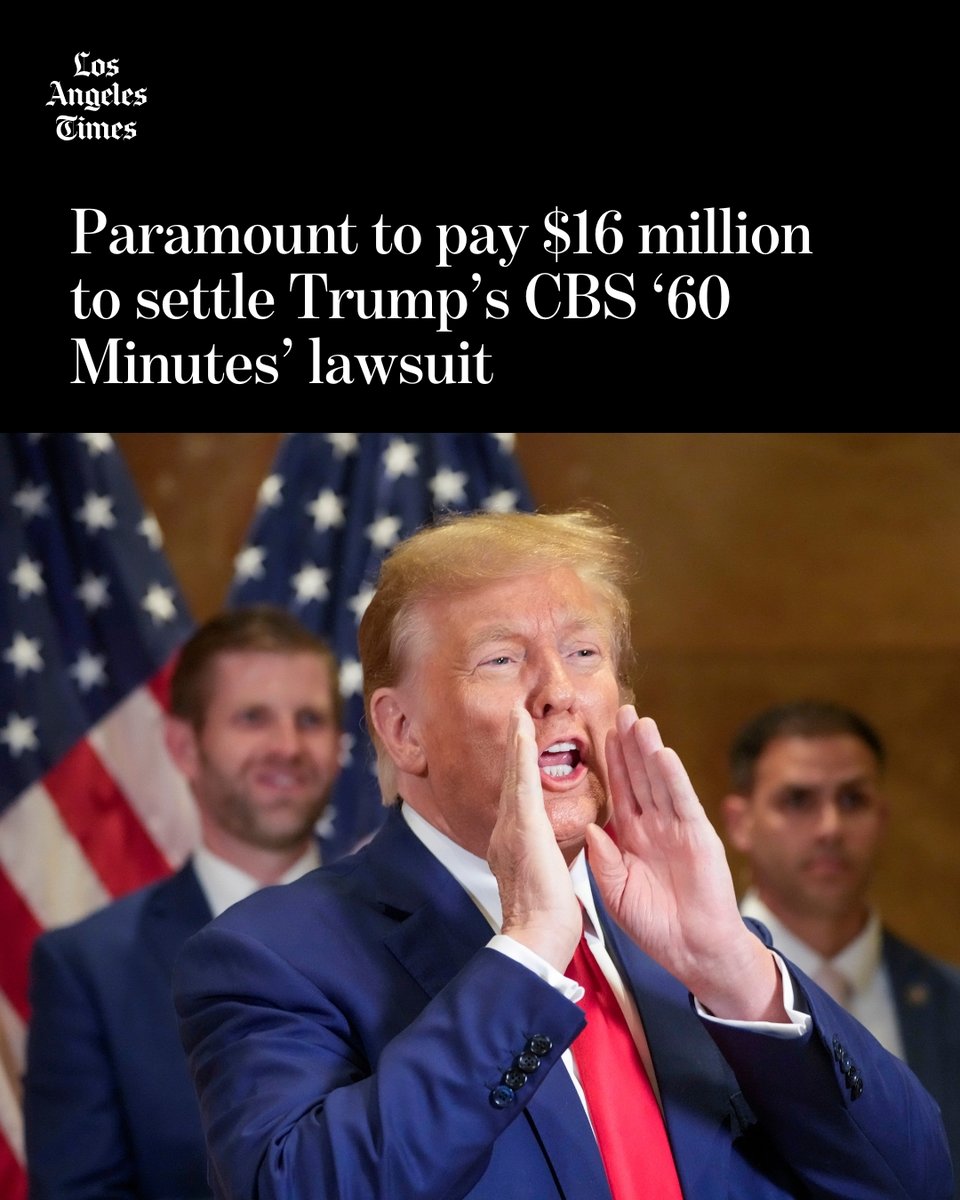
This looks like bribery in plain sight.
— Elizabeth Warren (@SenWarren) July 2, 2025
Paramount folded at the same time it needs Trump's approval for a billion-dollar merger.
I’m calling for an investigation into whether any anti-bribery laws were broken, and I'm working on a new bill to rein in this kind of corruption. https://t.co/xdkNpe75co
University of Pennsylvania.
UPenn Has Banned Trans Athletes From Women’s Sports

Penn Quakers swimmer Lia Thomas swims the 200 free at the NCAA Swimming & Diving Championships at Georgia Tech on March 18, 2022. Brett Davis/USA Today/Reuters
Another major university has capitulated to the Trump administration’s attacks on transgender rights. On Tuesday, the Department of Education and the University of Pennsylvania announced that the school will block transgender athletes from women’s sports teams as part of an agreement UPenn made with the federal government, CNN reports.
The Department also said the university will erase records set by Lia Thomas, who in 2022 became the school’s first openly transgender athlete to win an NCAA Division 1 title when she won the women’s 500-yard freestyle. (Thomas competed on the men’s team before transitioning.) In February — just one day after Trump signed an executive order moving to ban transgender athletes from girls’ and women’s sports — the NCAA changed its participation policy to limit competition in women’s sports to athletes assigned female at birth, with NCAA president Charlie Baker calling Trump’s order a “clear, national standard” in a statement at the time.
Also in February, the Department of Education opened an investigation into the University of Pennsylvania, concluding in April that the school had violated Title IX and the rights of its female athletes — a win for the Trump administration’s wider push to oust transgender athletes from girls’ and women’s sports. During the investigation, the White House cut $175 million in federal funding to the school. CNN reports that it’s “unclear” as to whether that money will now be restored to the University of Pennsylvania.
In the meantime, it certainly sounds like the school is bending the knee: Under the terms of the new agreement, UPenn will restore Division I records and titles to athletes who lost to Thomas, and send them personalized apology letters. The Department also says the university must announce that it “will not allow males to compete in female athletic” programs and must use “biology-based” definitions of male and female.
Following news of the agreement, the university has been doing its fair share of embarrassing bloviation. “While Penn’s policies during the 2021–2022 swim season were in accordance with NCAA eligibility rules at the time, we acknowledge that some student-athletes were disadvantaged by these rules,” University of Pennsylvania president J. Larry Jameson said in a news release about the agreement on Tuesday. “We recognize this and will apologize to those who experienced a competitive disadvantage or experienced anxieties because of the policies in effect at the time,” adding that the university has now brought “a close to an investigation that, if unresolved, could have had significant and lasting implications” for the school. Of course, there was no mentioned of the lasting impact the decision will have on trans athletes.
Thomas has yet to publicly comment on the university’s agreement. Addressing the bigotry she faced on the swim team with Sports Illustrated in 2022 — teammates apparently asked to exclude her from the conference championship meet, and parents openly opposed her eligibility to compete — Thomas said: “The very simple answer is that I’m not a man. I’m a woman, so I belong on the women’s team. Trans people deserve that same respect that every other athlete gets.” (New York magazine, The Cut).
Are you a Penn alumnus/alumna? You can contact the President of the University of Pennsylvania, J. Larry Jameson, MD, PhD, at the Office of the President:
• Address: 1 College Hall, Room 100, Philadelphia, PA 19104-6380
• Phone: 215-898-7221
• Email: president@upenn.edu
Others did not.
Harvard Kennedy School.
Harvard Kennedy School’s Plan B for International Students.
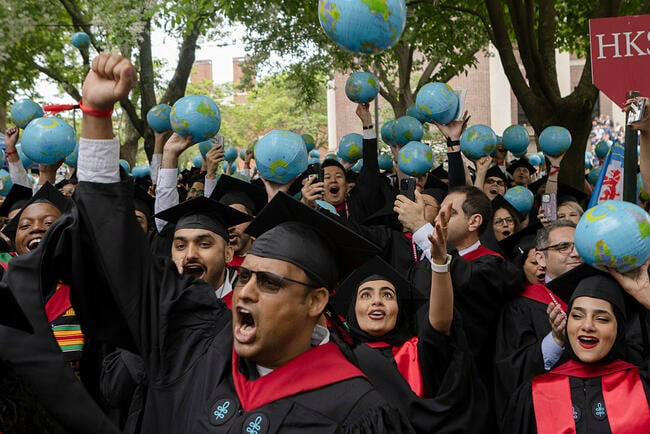
Harvard Kennedy School commencement in May 2025. More than half of the college’s students are international.
The Harvard Kennedy School announced a contingency plan for its international students Tuesday in the event that the Trump administration successfully bars the university from enrolling foreign students, according to The Boston Globe.
The Kennedy School, Harvard’s postgraduate college of government, public policy and international affairs, said that both incoming and returning students could study remotely, and returning students would be given the option to finish their degree at the University of Toronto’s Munk School of Global Affairs and Public Policy.
“We are announcing these contingency plans now to alleviate the uncertainty many students feel, but we will not officially launch these programs unless there is sufficient demand from students who are unable to come to the United States,” Kennedy School dean Jeremy Weinstein wrote in an email Tuesday.
Harvard needs the approval of its accreditor, the New England Commission of Higher Education, to allow students to complete their degrees online, and current students who want to study in Toronto would have to apply for a Canadian visa next month.
The Kennedy School is the first college at the university to release its formal contingency plan; others are working on developing their own. HKS is particularly vulnerable to a foreign student ban: 59 percent of its students are international, compared to 24 percent of Harvard’s total student population.
Harvard is currently suing the Trump administration over multiple attempts to ban its foreign student population, including by revoking the university's Student Exchange and Visitor Program certification and issuing an executive proclamation. Last Friday, a federal judge granted Harvard a preliminary injunction in one of its court challenges.
Even if the Trump administration’s efforts targeting Harvard specifically are struck down by the courts, other moves—such as revoking Chinese students’ visas en masse or banning nonimmigrant visa holders from a dozen countries—could prevent some of the Kennedy School’s current and incoming students from attending.(Inside Higher Education)
You did this.
Do you remember when you worked and donated to get Janet Protasiewicz elected to the Wisconsin Supreme Court in 2023, for a 4-3 liberal majority, and Susan Crawford in 2025 to keep the majority going?
Wisconsin Supreme Court’s liberal majority strikes down 176-year-old abortion ban - ABC News
MADISON, Wis. -- The Wisconsin Supreme Court’s liberal majority struck down the state’s 176-year-old abortion ban on Wednesday, ruling 4-3 that it was superseded by a newer state law that criminalizes abortions only after a fetus can survive outside the womb.
State lawmakers adopted the ban in 1849, making it a felony when anyone other than the mother “intentionally destroys the life of an unborn child.”
It was in effect until 1973, when the U.S. Supreme Court’s landmark Roe v. Wade decision legalizing abortion nationwide nullified it. Legislators never officially repealed the ban, however, and conservatives argued that the U.S. Supreme Court’s 2022 decision to overturn Roe reactivated it.
Wisconsin Attorney General Josh Kaul, a Democrat, filed a lawsuit that year arguing that the ban was trumped by abortion restrictions legislators enacted during the nearly half-century that Roe was in effect. Kaul specifically cited a 1985 law that essentially permits abortions until viability. Some babies can survive with medical help after 21 weeks of gestation.
Sheboygan County District Attorney Joel Urmanski, a Republican, defended the ban in court, arguing that the 1849 ban could coexist with the newer abortion restrictions, just as different penalties for the same crime coexist.
Dane County Circuit Judge Diane Schlipper ruled in 2023 that the 1849 ban outlaws feticide — which she defined as the killing of a fetus without the mother’s consent — but not consensual abortions. Abortions have been available in the state since that ruling but the state Supreme Court decision gives providers and patients more certainty that abortions will remain legal in Wisconsin.
Urmanski asked the state Supreme Court to overturn Schlipper’s ruling without waiting for a decision from a lower appellate court. It was expected as soon as the justices took the case that they would overturn the ban. Liberals hold a 4-3 majority on the court and one of them, Janet Protasiewicz, openly stated on the campaign trail that she supports abortion rights.
Democratic-backed Susan Crawford defeated conservative Brad Schimel for an open seat on the court in April, ensuring liberals will maintain their 4-3 edge until at least 2028. Crawford has not been sworn in yet and was not part of Wednesday’s ruling. She’ll play pivotal role, though, in a separate Planned Parenthood of Wisconsin lawsuit challenging the 1849 ban’s constitutionality. The high court decided last year to take that case. It’s still pending.
You can do this too.
Trump set July 4th as the deadline for the Congress to pass his BIG UGLY BILL. Your calls may determine if that will ever happen.
Help 17 Million Americans keep their Health Care.
House Republicans do not have the votes right now to pass the Big Ugly Bill and take Medicaid away and kill people. It would be a shame if word got out about this.
— Aaron Black (@ABlackPolitical) July 2, 2025
Keep making phone calls to their offices! pic.twitter.com/SkEJKsUWHD
202-225-3121!
HBO and Max(streaming) began showing ‘Dear Ms.’ last night.
Still Naming the Problem: HBO Documentary 'Dear Ms.' Celebrates the Radical Origins—and Ongoing Impact—of Ms. Magazine.

The new documentary Dear Ms.: A Revolution in Print, celebrating the trailblazing history and enduring impact of Ms. magazine, premiered at the Tribeca Film Festival in June and is available to stream on HBO Max beginning Wednesday, July 2, at 9 p.m. ET/PT.
With intimate interviews, rare archival footage and excerpts from the Ms. book, 50 Years of Ms.: The Best of the Pathfinding Magazine That Ignited a Revolution (September 2023, Knopf), filmmakers Salima Koroma, Alice Gu and Cecilia Aldarondo and producer and documentary filmmaker Dyllan McGee shine a spotlight on the magazine’s early days as a radical force for feminism, equality and truth-telling.
It’s a thrilling and timely reminder: Ms. has always named the problem—and we still do.

Gloria Steinem (right) is presented with a framed copy of the Fall 2009 cover of Ms. magazine, featuring her and Alice Walker, by Ms. executive editor Kathy Spillar (left) and Ms. publisher Ellie Smeal, on Oct. 5, 2009, in Washington. Steinem founded Ms. in 1972. The Feminist Majority Foundation began publishing Ms. in 2001. (Brendan Hoffman / Getty Images)
The documentary features icons like Gloria Steinem, Letty Cottin Pogrebin, Marcia Ann Gillespie, Pat Carbine and Suzanne Braun Levine, along with some of the writers, editors and organizers who broke silence on abortion, sexual harassment, pay inequity and domestic violence—issues still making headlines today. In doing so, the film reminds us of a truth we’ve always known: Women’s voices change the world.

Patricia Carbine and Gloria Steinem in front of a mockup of the cover of the fifth anniversary issue of the magazine on July 12, 1977. (Bettman Archives / Getty Images)
I hope you are able to get access to this documentary. You will laugh and cry, remember and learn. It is worth making the effort to see it.